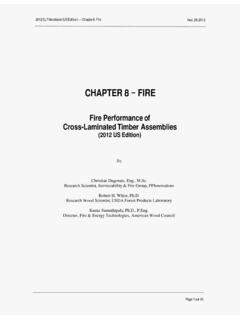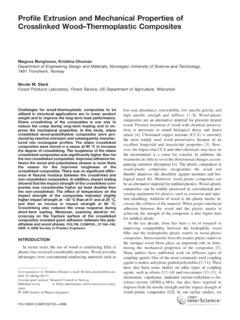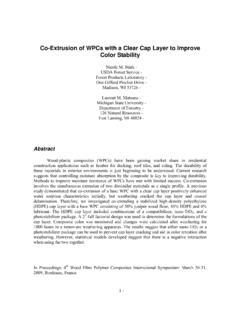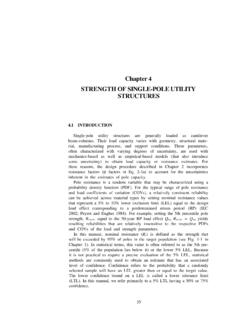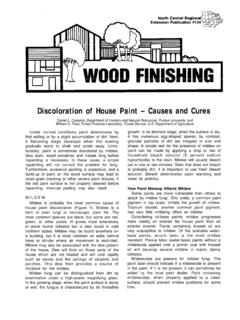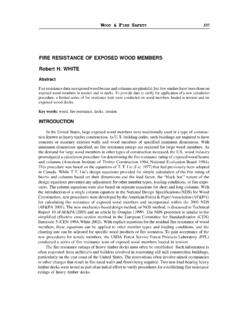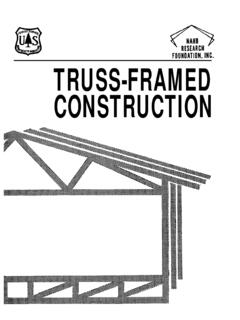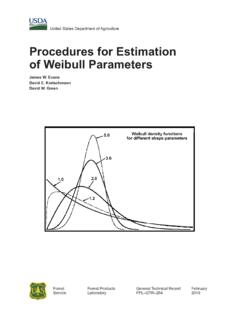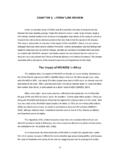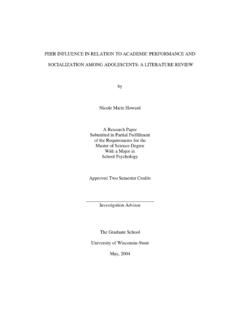Transcription of Wood Handbook, Chapter 11: Mechanical Properties of …
1 Chapter 12 Mechanical Properties of Wood-Based Composite MaterialsZhiyong Cai, Supervisory Research Materials EngineerRobert J. Ross, Supervisory Research General Engineer12 1 Contents Elastic Properties 12 2 Modulus of Elasticity 12 2 Shear Modulus 12 3 Strength Properties 12 3 Panel Products 12 3 Plywood 12 3 Oriented Strandboard (OSB) 12 4 Particleboard 12 4 Hardboard 12 4 Medium-Density Fiberboard 12 5 Timber Elements/Structural Composite Lumber 12 5 Glued-Laminated Timber 12 5 Structural Composite Lumber 12 6 Wood Nonwood Composites 12 7 Wood Plastic Composite 12 7 Inorganic-Bonded Composites 12 9 Testing Standards 12 9 Literature Cited 12 10 The term composite is used to describe any wood material bonded together with adhesives.
2 The current product mix ranges from fiberboard to laminated beams and components. In this Chapter , wood-based composite materials are classi-fied into the following categories: panel products (plywood, oriented strandboard (OSB), particleboard, fiberboard, medium-density fiberboard (MDF), hardboard); structural timber products (glued-laminated timber (glulam), lami-nated veneer lumber (LVL), laminated strand lumber, paral-lel strand lumber); and wood nonwood composites (wood fiber thermoplastics, inorganic-bonded composites).Wood-based composites are used for a number of structural and nonstructural applications. Product lines include panels for both interior and exterior uses, furniture components, and support structures in buildings.
3 Knowledge of the me-chanical Properties of these products is of critical impor-tance to their proper composites are made from a wide range of materials from fibers obtained from underutilized small-diameter or plantation trees to structural lumber. Regardless of the raw material used in their manufacture, wood-based composites provide uniform and predictable in-service performance, largely as a consequence of standards used to monitor and control their manufacture. The Mechanical Properties of wood composites depend upon a variety of factors, including wood species, forest management regimes (naturally regenerated, intensively managed), the type of ad-hesive used to bind the wood elements together, geometry of the wood elements (fibers, flakes, strands, particles, veneer, lumber), and density of the final product (Cai 2006).
4 A wide range of engineering Properties are used to charac-terize the performance of wood-based composites. Mechani-cal Properties are typically the most frequently used to eval-uate wood-based composites for structural and nonstructural applications. Elastic and strength Properties are the primary criteria to select materials or to establish design or product specifications. Elastic Properties include modulus of elastic-ity (MOE) in bending, tension, and compression. Strength Properties usually reported include modulus of rupture (MOR, bending strength), compression strength parallel to surface, tension strength parallel to surface, tension strength perpendicular to surface (internal bond strength), shear strength, fastener holding capacity, and hardness.
5 Model 12 2building codes in the United States stipulate that plywood used for structural applications such as subflooring and sheathing must meet the requirements of certain De-partment of Commerce standards. Voluntary Product Stan-dard PS 1 07 for construction and industrial plywood (NIST 2007) and Performance Standard PS 2 04 for wood-based structural-use panels (NIST 2004) spell out the ground rules for manufacturing plywood and establishing plywood or OSB Properties , respectively. These standards have evolved over time from earlier documents (O Halloran 1979, 1980; APA 1981) and represent a consensus opinion of the mak-ers, sellers, and users of plywood products as well as other concerned of the questions that arise with wood-based compos-ites have to do with their Mechanical Properties , especially how Properties of one type of material compare with those of clear wood and other wood products.
6 Although an ex-tensive review that compares all Properties of wood-based materials and products is beyond the scope of this Chapter , Table 12 1 provides some insight to how static bending Properties of these materials vary and how their Properties compare with those of solid, clear wood. Although the me-chanical Properties of most wood composites might not be as high as those of solid wood, they provide very consistent and uniform Mechanical property data presented in this Chapter were obtained from a variety of reports of research conducted to develop basic property information for a wide range of wood-based composite materials. The wood-based com-posites industry is very dynamic, with changes occurring frequently in the manufacture of these materials and cor-responding changes in design information.
7 Consequently, this Chapter primarily focuses on presenting fundamental Mechanical property information for wood-based composite materials. For design procedures and values, the reader is encouraged to contact the appropriate industry trade asso-ciation or product manufacturers. Current design informa-tion can be readily obtained from their websites, technical handbooks, and organization of this Chapter follows closely that of Chapter 5. Basic Mechanical property information is pre-sented following a brief background discussion of these products. A discussion of performance and testing standards covering their manufacture and use is also PropertiesModulus of Elasticity Elasticity implies that deformations produced by low stress below the proportional limit are completely recoverable after loads are removed.
8 When loaded to stress levels above the proportional limit, plastic deformation or failure occurs. Typically, the stress strain curve for wood-based compos-ites is linear below the proportional limit. The slope of the linear curve is the MOE. In compression or tensile tests, this slope is sometime referred to as Young s modulus to differ-entiate it from bending MOE. Bending MOE is a measure of the resistance to bending deflection, which is relative to the stiffness. Young s modulus is a measure of resistance to elongation or shortening of a member under tension or compression. The procedure to determine MOE is fully de-scribed in ASTM D 1037 for fiber- and particle-based panel products, ASTM D 3043 for structural wood-based panels, ASTM D 5456 for structural composite lumber products, General Technical Report FPL GTR 190 Table 12 1.
9 Static bending Properties of different wood and wood-based compositesMaterial Specific gravityStatic bending Properties Modulus of elasticity Modulus of rupture GPa ( 106 lb in 2) MPa (lb in 2)Clear wood White oak ( ) (15,200) Red maple ( ) (13,400) Douglas-fir (Coastal) ( ) (12,400) Western white pine ( ) (9,700) Longleaf pine ( ) (14,500) Panel products Hardboard ( ) (4,500 8,200) Medium-density fiberboard ( ) (5,200) Particleboard ( ) (2,200 3,500) Oriented strandboard ( ) (3,161 5,027) Plywood ( ) (4,890 6,180) Structural timber products Glued-laminated timber ( ) (4,150 9,080) Laminated veneer lumber ( ) (4,900 12,500)Wood nonwood composites Wood plastic ( ) (3,684 7,585) 12 3 Chapter 12 Mechanical Properties of Wood-Based Composite MaterialsASTM D 7031 for wood plastic composites, and ASTM D 7341 for glulam ModulusShear modulus, also called modulus of rigidity, indicates the resistance to deflection of a member caused by shear stresses.
10 Shear stress is different from tension or compres-sion stress in that it tends to make one side of a member slip past the other side of a member adjacent to it. There are two main types of shear in different planes of wood-based pan-els: interlaminar shear and edgewise shear or shear through-the-thickness. Interlaminar shear is also commonly called planar shear (or rolling shear, or horizontal shear) in ply-wood panels to describe stress that acts between the veneers that are glued with grain direction in adjacent pieces per-pendicular to one another. For example, when the plywood panel is loaded in the middle with its two ends simply sup-ported, the layers or veneers tend to slip horizontally past each other as the panel bends.


